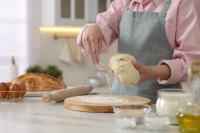Food
The flavours of Sri Lanka
Krishanti Weerakoon demonstrated how to cook a variety of dishes from her native country, with detailed recipes, in a recent cookout session with the Post.
Anweiti Upadhyay
On a pleasant spring morning, The SAARC House was abuzz with activity. A tent was propped up in the courtyard. More than a dozen women and men were seated underneath it. Colourful leaflets with detailed recipes for Sri Lankan dishes were placed on each table. At the right side of the tent, different spices commonly used in Sri Lankan cooking were displayed in coconut shell bowls placed atop nanglos. Some spices were placed inside a teardrop-shaped box, made in the shape of the island nation with the Sri Lankan map printed on its lid.
The occasion was a cookout session hosted by Krishanti Weerakoon, who is the daughter and wife of a diplomat. She’s had a multidimensional life–a humanitarian worker in the United Nations, an etiquette expert and a former Director of Foreign Affairs in the Presidential Secretariat, Sri Lanka. She is currently in Nepal with her husband, Esala Weerakoon, the Secretary General of SAARC.
Most of the guests present at The SAARC House were members of Tasneem’s Cookout sessions organised by Tasneem’s King’s Kitchen. In these sessions, the restaurant’s founder Tasneem Shahani arranges for the members of the cookout to learn recipes from a different cuisine every month. Weerakon, who is very passionate about cooking, has been attending Shahani’s cooking classes for some time. “Krishanti was very interested in showcasing Sri Lankan cuisine through the cookout session. Since there aren’t any Sri Lankan restaurants in Kathmandu, we thought this would be a great way to introduce the cuisine to our members,” says Shahani.
As the attendees were buzzing about with excitement, murmuring amongst each other while reading through the leaflet, Weerakon entered in a turquoise saree with a big smile on her face. She greeted everyone in the vicinity, addressing each person by their name, and everybody greeted her back. The session began with the host explaining how each of the displayed spices is used in Sri Lankan cooking. She spoke of the rich diversity of food and styles seen in the country’s cuisine.
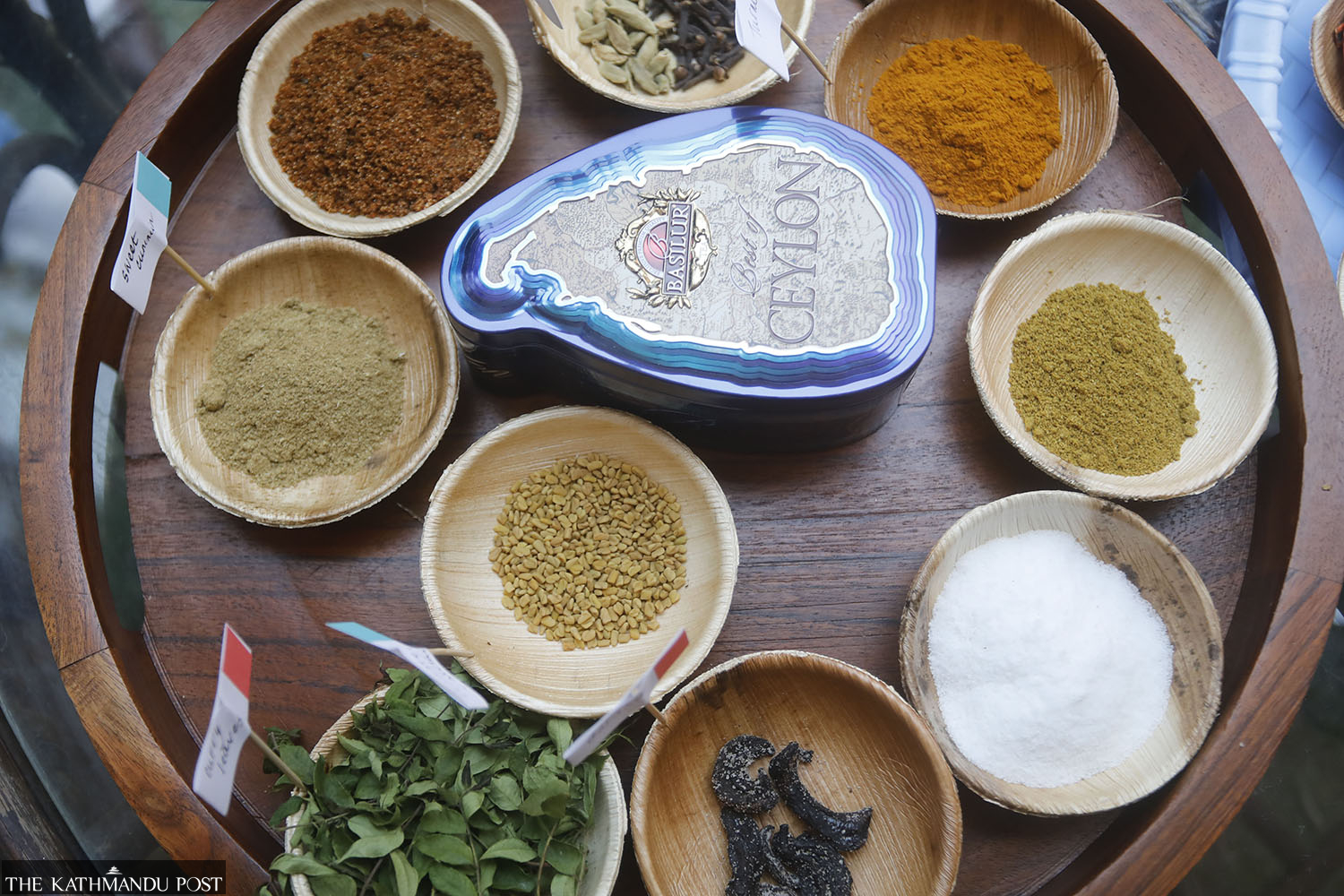
In spite of its small size, Sri Lanka boasts an amazing diversity of food and styles of cooking. Sri Lankan cooking takes advantage of the wide variety of native fruit and vegetables, as well as the many spices that grow on the island. Coconut and coconut milk are also among the major ingredients used. Rice is the staple. Fresh and dried seafood is, of course, plentiful. The island has a rich heritage of native dishes, and its regional cooking is varied. For example, cuisine in the Central Province has its emphasis on hill country vegetables and fruits; coastal area cooking utilises seafood, and South Indian cuisine has widely influenced culinary practices in the Northern and Eastern provinces.
In addition to the regional characteristics, some of the popular dishes reflect influences from other lands. Sri Lanka has a colonial legacy of almost 450 years, with foreigners who came and stayed, either as traders or conquerors—including the Indians, Arabs, Malays, Moors, Portuguese, Dutch and British. They have influenced the nation’s cuisine.
Then, Weerakoon, assisted by Manju Thapa Magar and Binita KC, the head and assistant chefs at The SAARC House, demonstrated how a variety of dishes from Sri Lanka—namely, chicken curry, bean curry, Brinjal Moju, and cashew curry—are made. This was followed by chef Anoma Shrestha, who runs a catering service in Kathmandu and is Sri Lankan by birth, demonstrating how to make hoppers, Sri Lankan style.
The session ended with a big feast, made in The SAARC House, that featured every dish demonstrated earlier alongside other delicacies, including Wattalapam, Pol Sambol, Lunu Miris and Kiri Bath, among others.
I found Sri Lankan cuisine quite similar to Nepali. Coconut milk gives it a unique flavourful sweetness that isn’t present in most Nepali dishes—the savoury ones, at least. Some of the dishes served were also quite spicy—all too fitting for the Nepali palette.
RECIPES BY KRISHANTI WEERAKOON
Bean curry
Difficulty: ⅕
Spiciness: ⅓
Serves: 5

Ingredients:
250 grams of tender beans
½ teaspoon turmeric
A few fenugreek seeds
1 small onion chopped
2 green chillies deseeded
8 curry leaves
1/2 teaspoon unroasted curry powder
Small piece of cinnamon
½ teaspoon salt
Garlic
1 cup coconut milk
Directions:
Wash the beans and slice them diagonally. Heat oil in a small pan and put the onion, garlic, fenugreek, green chilli, rampe (a shrub with musky-scented leaves) and curry leaves into it. Then add the beans, salt and turmeric and saute lightly. Cover and cook on low heat for a few minutes. Lastly, add a little coconut milk and let it cook for a moment.
Brinjal Moju
Difficulty: 3/5
Spiciness: ⅓
Serves: 8
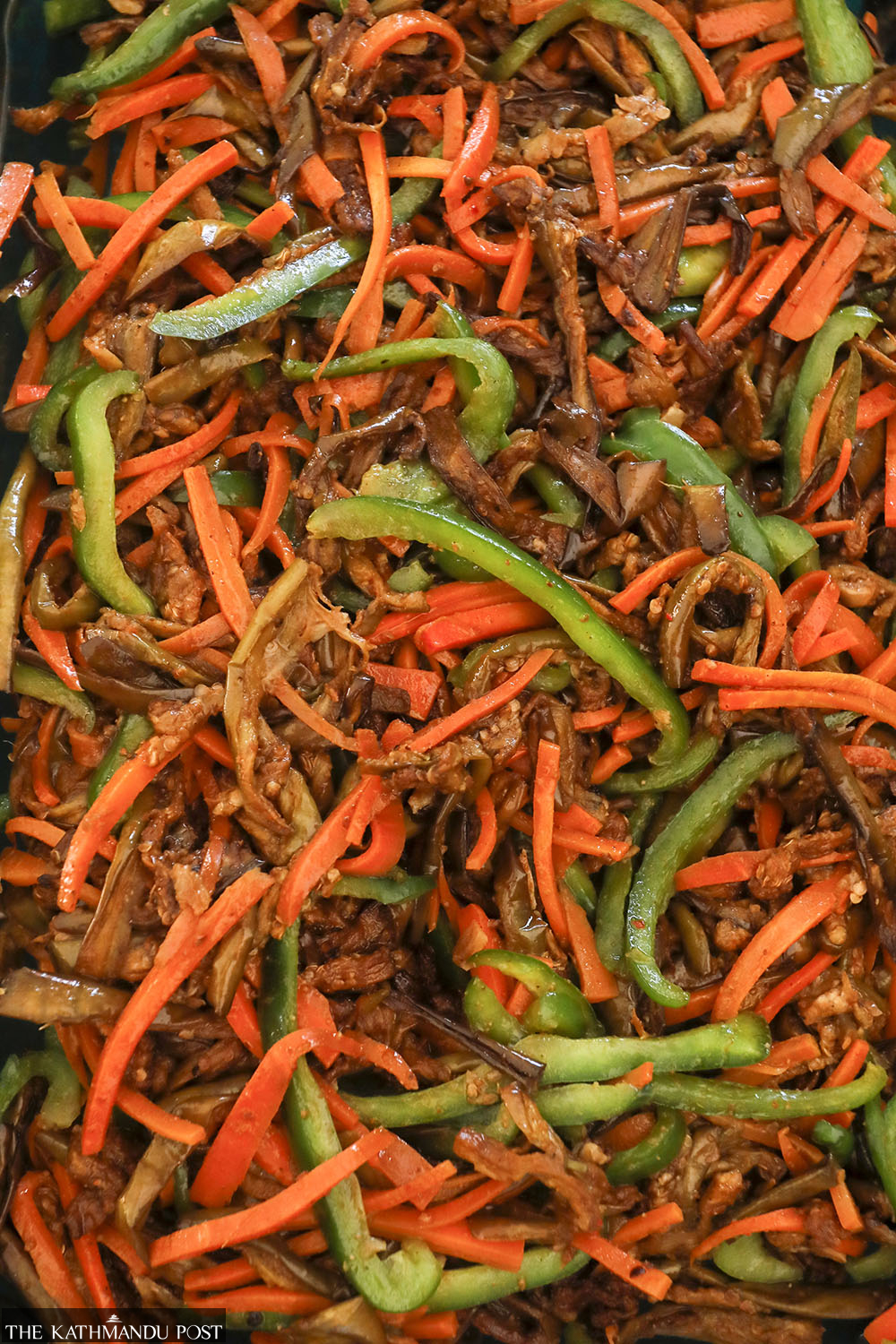
Ingredients:
1 kilo brinjals ( eggplant)
1 teaspoon turmeric powder
11/2 teaspoons salt
Oil for frying
4 Onions sliced finely
1 oz ground ginger and garlic
1 tablespoon mustard seeds soaked in vinegar and ground to a fine paste
2 carrots cut into large matchsticks and lighted boiled in vinegar
1 large capsicum cut into slices
1 tablespoon coriander powder
2 teaspoons roasted cumin powder
1 teaspoon sweet cumin powder
½ teaspoon chilli powder
½ bottle vinegar
1 tablespoon jaggery or sugar
Directions:
Wash and wipe the brinjals and cut lengthwise. Rub with salt and turmeric and leave aside for a few minutes. Heat oil in a pan and deep fry the brinjals a little at a time and fry until golden brown. Drain well.
Grind the mustard seeds in vinegar to a paste and add the coriander, cumin and sweet cumin powder to the mustard paste. Then add the ground ginger and garlic together with the chilli powder. Lastly, add the jaggery.
Put all these ingredients into a large pan and boil for a few minutes. Then add the brinjals and simmer for 3-5 minutes. Take out of the fire and adjust the seasoning and add the carrots, capsicum and onions to the brinjals and add a squirt of lime to taste.
Cashew curry
Difficulty: 2/5
Spiciness: ⅓
Serves: 4-6
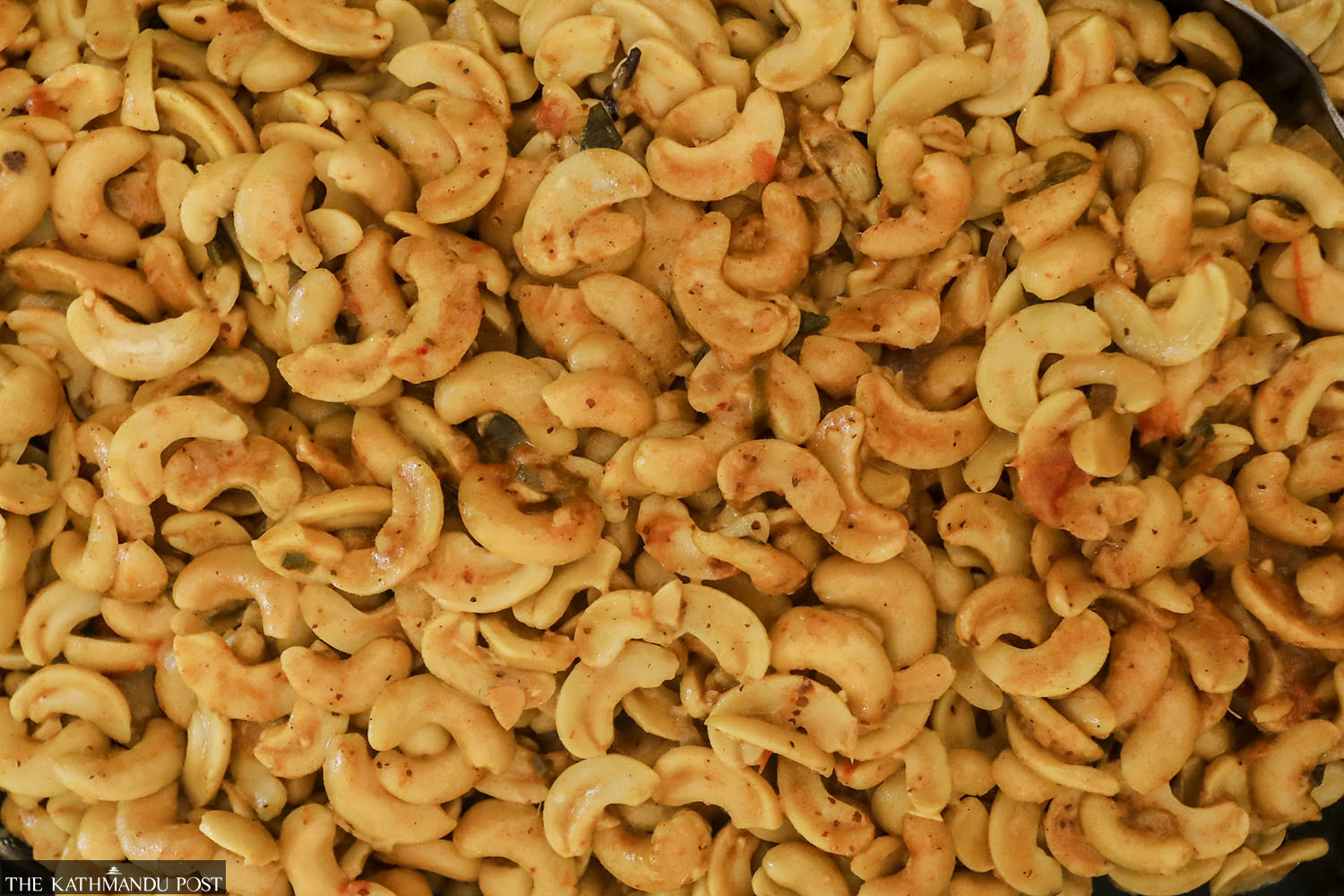
Ingredients:
225grams dried unroasted cashew nuts
1 tablespoon chopped onion
A few seeds of fenugreek
1/2 teaspoon of unroasted curry powder
3 cloves garlic
1/2 inch ginger chopped
A 2-inch cinnamon stick
10 curry leaves, a stick of lemon grass, a few rampe
½ teaspoon turmeric powder
Salt to taste
1 cup thin coconut milk
½ cup thick coconut milk
Directions:
Soak the dried cashew nuts overnight in cold water. Put all the ingredients except for the salt and thick milk in a pan and simmer gently uncovered for 10 minutes or until the cashews are tender. Add the salt and thick milk and simmer for a further 5 minutes stirring occasionally. The gravy should be fairly thick.
This recipe can be used to cook other vegetables, including beans, cabbage, potatoes and okra.
Chicken curry
Difficulty: 3/5
Spiciness: 2/3
Serves: 5
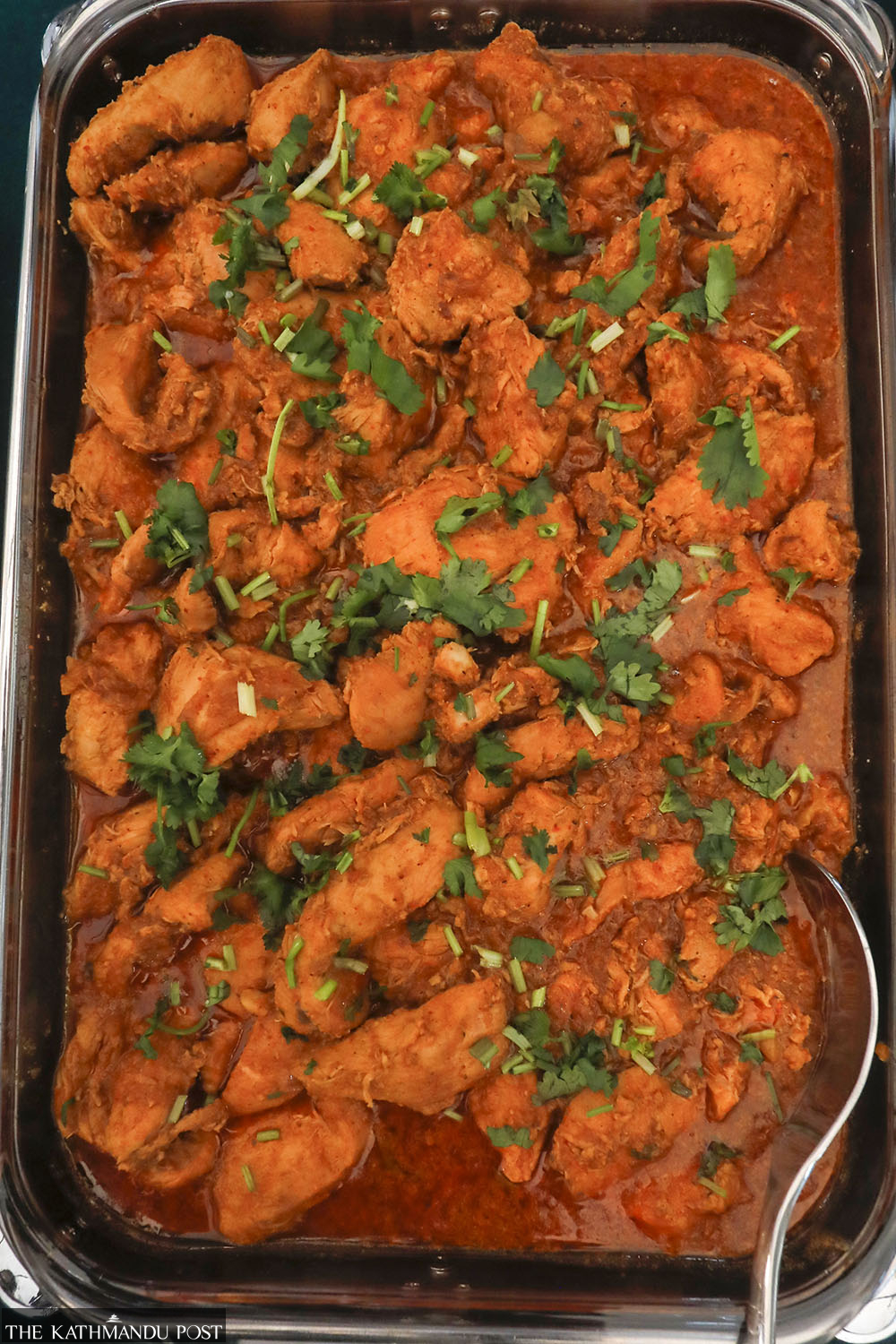
Ingredients:
1 kilo chicken
15 dried red chillies
1 tablespoon coriander
2 teaspoons cumin seed
Sprig of curry leaves
1 piece of cinnamon
1 tsp of peppercorns
1 tablespoon of dried raw rice
2 tablespoons grated coconut
1 tablespoon tamarind extract
½ tsp turmeric
1 onion sliced
2 green chillies chopped
Curry leaves, rampe, lemon grass
2 cloves and 2 cardamoms
2 tablespoons Garlic and ginger paste
1 cup thin coconut milk
1 cup thick coconut milk
1 tablespoon oil
Directions:
Roast dried chillies, dried raw rice, grated coconut, coriander, cumin, sweet cumin curry leaves and cinnamon until golden brown colour and blend into a powder. Marinade the cut chicken with ground curry powder, tamarind, and salt. In a saucepan, heat 1 tablespoon of oil and fry the onions, green chillies, ginger and garlic paste, curry leaves, rampe, lemon grass, cloves, cardamoms and cinnamon. Add the marinated chicken and fry for a few minutes. Then add thin milk and cook on a slow fire until the chicken is tender. Add the thick milk and allow it to simmer. Remove from heat when the gravy is thick and add a squirt of lime juice to taste.
Pol Sambol
Difficulty: 1/5
Spiciness: 3/3
This coconut sambol is very popular in Sri Lanka. With a balanced flavour—sweet from the coconut, hot from the chilli and pepper and tangy from the lime—it is a versatile dish that is delicious to have with rice or bread.
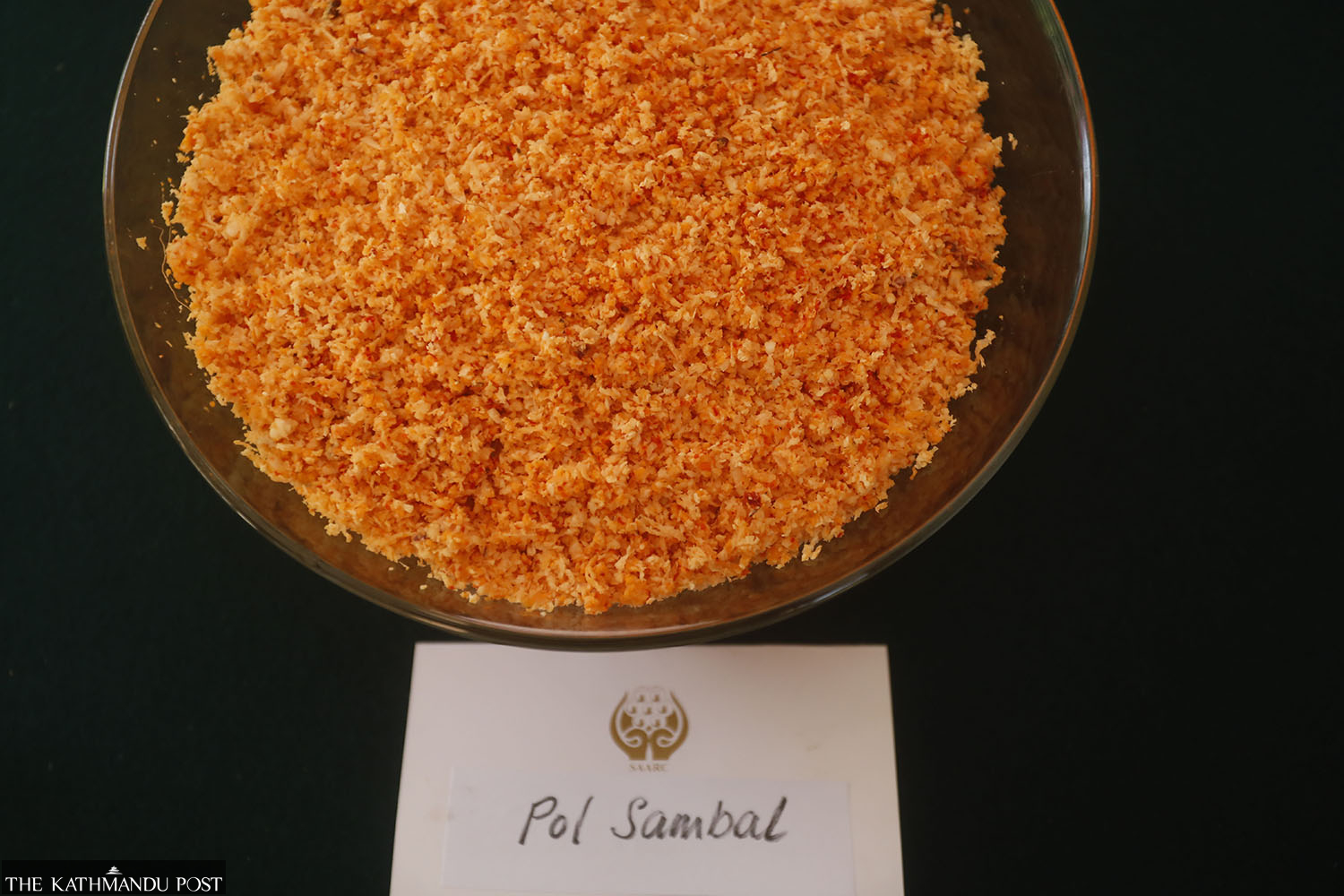
Ingredients:
5 and a half cups grated coconut
6 dried chillies
6 red onions or one big onion
1 clove garlic
Salt and lime to taste
2 teaspoons flaked Maldive fish (a type of dried fish)
2 green chillies and 2 teaspoons chopped tomato
Directions:
Grind the dried chillies with a little salt. Add the red onions, garlic and Maldive fish and grind lightly. Add the coconut and grind lightly until blended with the other ingredients. Add the lime to taste, chopped tomato and green chillies.
Wattalapam
Difficulty: ⅗
Spiciness: 0/3
Serves: 8
Ingredients:
350 grams Jaggery grated
2 cups thick coconut milk
8 eggs
1 tablespoon cornflour
½ teaspoon grated nutmeg
¼ teaspoon powdered cardamom seeds
½ cup sliced cajun
Directions:
Beat the eggs lightly and add the ingredients and mix well. Strain and pour into a bowl. Cover the bowl with a saucer and place the bowl in a saucepan of simmering water and steam for 30-40 minutes. The water should not boil but simmer gently until the Wattalapam is well cooked. Remove from heat and allow to cool. Serve hot or cold.




 22.65°C Kathmandu
22.65°C Kathmandu





